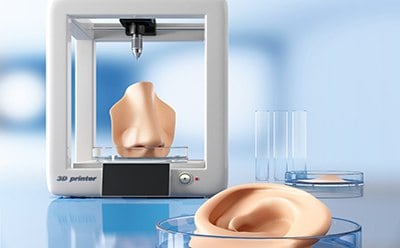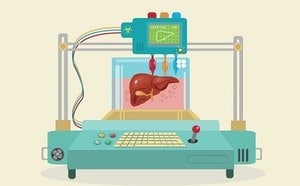3D Bioprinting

3D bioprinting is an additive manufacturing process with biomaterials, living cells, and active biomolecules to fabricate structures that imitate natural tissue characteristics. Bioprinting differs from 3D printing primarily by the addition of living cells to non-toxic hydrogels that mimic the extracellular matrix environment to support cell adhesion, proliferation, and differentiation after printing.
The bioprinting process begins with 3D imaging to obtain the exact dimensions of the tissue. Similar to conventional 3D printing, a digital model is created with layer-by-layer instructions to make a physical 3D object. In order to optimize cell viability and ensure a printing resolution adequate for homogenous distribution of cells, sterile printing conditions are required. Depending on the application, the biomaterial, e.g. alginate, collagen, gelatin, or hyaluronan, to support cell growth is combined with living cells to form the bioink. Using a highly controlled, layer-by-layer approach, bioink is deposited with extrusion-, inkjet- or laser-based 3D printing technique. These 3D tissue constructs solidify by UV light, chemically stimulation, or heat for a stable growth environment.
Due to its high degree of control, 3D bioprinting has emerged as a key research technique for drug testing and clinical trials, functional organ replacement, regenerative medicine, and other bio printing applications for cosmetic and personal care. Researchers are actively developing new materials and printing methods for 3D printing in medicine to be able to tune the properties of the printed constructs and more closely mimic the mechanical properties of skin, bone and cartilage, neural, cardiac, muscular, and dental tissue types.
Featured Categories
Discover our selection of polyethylene glycol (PEGs) and PEG derivatives in a wide range of molecular weights for all your PEGylation needs and applications.
Biocompatible materials and bioinks optimized for 3D bioprinting and tissue engineering ensure high printing fidelity and cell viability.
We offer an extensive range of natural and synthetic biomedical polymers with advanced properties suitable for all your biomedical applications.
Explore our portfolio of versatile hydrophobic polymers to support your adhesion, coating, fiber, film, engineered plastic and biomedical applications.
The bioprinting process begins with 3D imaging to obtain the exact dimensions of the tissue. Similar to conventional 3D printing, a digital model is created with layer-by-layer instructions to make a physical 3D object. In order to optimize cell viability and ensure a printing resolution adequate for homogenous distribution of cells, sterile printing conditions are required. Depending on the application, the biomaterial, e.g. alginate, collagen, gelatin, or hyaluronan, to support cell growth is combined with living cells to form the bioink. Using a highly controlled, layer-by-layer approach, bioink is deposited with extrusion-, inkjet- or laser-based 3D printing technique. These 3D tissue constructs solidify by UV light, chemically stimulation, or heat for a stable growth environment.
Due to its high degree of control, 3D bioprinting has emerged as a key research technique for drug testing and clinical trials, functional organ replacement, regenerative medicine, and other bio printing applications for cosmetic and personal care. Researchers are actively developing new materials and printing methods for 3D printing in medicine to be able to tune the properties of the printed constructs and more closely mimic the mechanical properties of skin, bone and cartilage, neural, cardiac, muscular, and dental tissue types.
Visit our document search for data sheets, certificates and technical documentation.
Related Articles
- Find use of RESOMER® biodegradable polymers in medical device applications research.
- Three-dimensional (3D) printing of biological tissue is rapidly becoming an integral part of tissue engineering.
- In the past two decades, tissue engineering and regenerative medicine have become important interdisciplinary fields that span biology, chemistry, engineering, and medicine.
- Professor Shrike Zhang (Harvard Medical School, USA) discusses advances in 3D-bioprinted tissue models for in vitro drug testing, reviews bioink selections, and provides application examples of 3D bioprinting in tissue model biofabrication.
- Discussion of synthetic modifications to gelatin, improving the three-dimensional (3D) print resolution, and resulting material properties.
- See All (12)
Find More Articles and Protocols
How Can We Help
In case of any questions, please submit a customer support request
or talk to our customer service team:
Email custserv@sial.com
or call +1 (800) 244-1173
Additional Support
- Chromatogram Search
Use the Chromatogram Search to identify unknown compounds in your sample.
- Calculators & Apps
Web Toolbox - science research tools and resources for analytical chemistry, life science, chemical synthesis and materials science.
- Customer Support Request
Customer support including help with orders, products, accounts, and website technical issues.
- FAQ
Explore our Frequently Asked Questions for answers to commonly asked questions about our products and services.
To continue reading please sign in or create an account.
Don't Have An Account?



